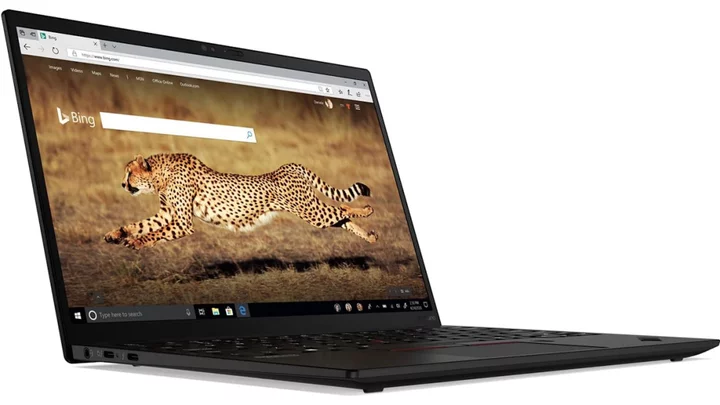One of the easiest Windows notebooks to carry around is Lenovo’s ThinkPad X1 Nano, with its 13-inch display, fast processor, and a weight of just about 2 pounds. This year’s model, dubbed Gen 3, is not all that different from last year’s, sporting a 13th Generation Intel Core (Raptor Lake) processor—making this in some ways the little brother to the 14-inch Lenovo ThinkPad X1 Carbon Gen 11.
As before, the X1 Nano is very easy to carry, measuring 0.57 by 11.5 by 8.2 inches (HWD), and weighing 2.1 pounds (2.7 pounds with the included 65-watt charger.) The model I tested sported a 2160 by 1350 LCD display, with the common 16:10 ratio, which is sharper than most lightweight notebooks. It has the familiar matte black casing, and distinctive keyboard (with the red TrackPoint pointing stick) that is common in the ThinkPad line.
The big difference in this year's model is the processor—the model I tested had an Intel Core i7-1360P, with 16GB of memory and a 512GB SSD. Like Intel's Core i7-1355, which I've seen in recent notebooks like the Lenovo ThinkPad X1 Carbon Gen 11 and X1 Yoga Gen 8, this is part of Intel's 13th Generation core family, but this one has four performance cores (each offering two threads each) along with eight efficient cores, thus a total of 12 cores and 16 threads and has a base power of 28 watts, instead of the 15-watt Core i7-1355, which has two performance cores with the eight efficient ones. Like the earlier chip, it has a maximum turbo frequency of 5.0GHz. The chip I tested on last year's model was an Intel i7- 1280P with six performance cores plus the eight efficiency ones, with a maximum turbo of 4.8GHz.
As a result, this year’s model scores about 10% better than last year’s on most common benchmark tests, and is generally comparable with this year’s X1 Carbon—slightly slower on some things, slightly faster on others, but very close.
However, on my tougher tests, it scored a bit worse than last year's model. A big portfolio simulation in MatLab took 36 minutes, compared with 33 last year, and converting a large file in Handbrake video conversion took an hour and 49 minutes, compared with an hour and 44 minutes last year. In both cases, the Nano Gen 3 was a bit better than what I saw with the X1 Carbon. A big Excel spreadsheet took 39 minutes to complete vs. 40 on last year’s model and 35 for the X1 Carbon. (Note that Ryzen-based machines, such as the Lenovo ThinkPad Z13, are much better at graphics-heavy tests such as the Handbrake one, but notably slower on Excel.)
On PCMark 10’s Modern Office battery test, I got about 11 and a half hours, which is nice—better than I saw last year, but not as good as on larger machines—understandable given the smaller 50 watt-hour battery.
Otherwise, the machine is very similar to last year’s. The display is very nice, and the model I had included a touch screen, which I do find very handy on laptops.
The biggest drawback to the Nano may be the relative lack of ports. The right side has two USB-C/Thunderbolt ports and a mic/headset jack. The left side just has a power button and some vents. There's no USB-A port, nor an HDMI port, or even a locking slot. Of course, you can get dongles to connect other devices, or a docking station—I used a slightly older ThinkPad Thunderbolt 3 dock—but it’s still not convenient while travelling. It would be better if there was a USB-port on either side, as that makes it easier to connect power.
On the positive side, the 1080p webcam seemed notably sharper than the one on the X1 Carbon, with a nice wide field of view; it’s not quite the best I’ve seen on a notebook but good. It has a physical webcam shutter, which I appreciate. The webcam worked well with Windows Hello for logging on; you can also use a fingerprint reader located to the right of the touchpad.
Speaking of the touchpad, it is somewhat smaller than the version on the X1 Carbon, not surprising given the sizes of the two machines, but still worked well. The keyboard feel is very similar—I continue to like typical ThinkPad keyboards.
On Lenovo’s website, as I write this, a model with a Core i5-1340P processor, Windows 11 Home, 256 GB SSD, and a non-touch display is available for $1,217. Configuring a model similar to what I tested, with a Core i7-1360P, Windows 11 Pro, 512 GB SSD, and touch screen raised the price to $1,614. Those prices are close to what I saw for the X1 Carbon.
As always, when it comes down to a laptop this light, there are tradeoffs. In this case, compared with the X1 Carbon, to save half a pound of weight, you get a slightly smaller (but higher resolution screen) and lose a number of ports, but get a better webcam. For people who travel a lot, this may be an excellent tradeoff.

